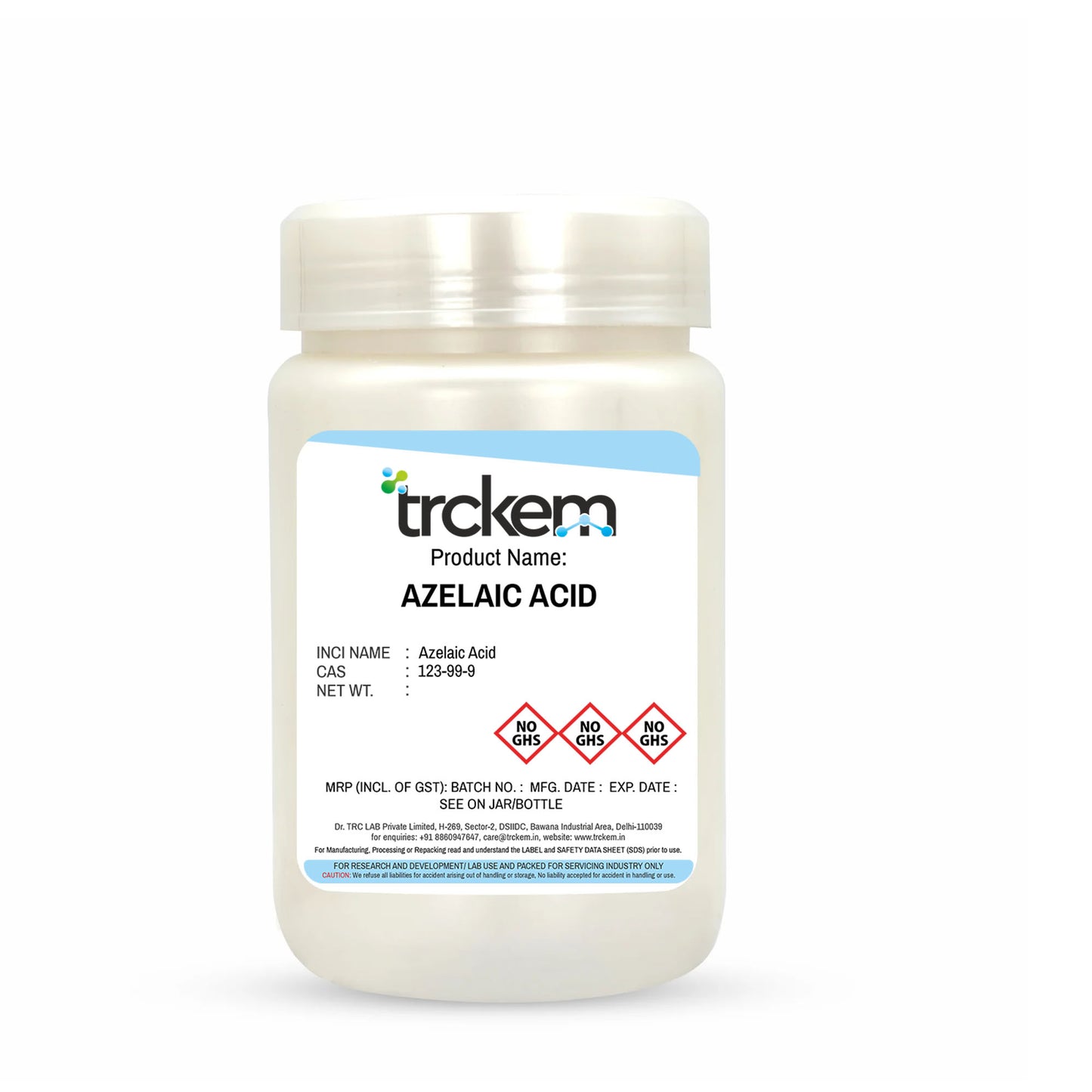

THE STORY OF AZELAIC ACID

Azelaic Acid: The Multi-Action Dermatology Active
Azelaic Acid is a naturally occurring dicarboxylic acid used in dermatology and cosmetic skincare for its anti-acne, depigmenting, and anti-inflammatory properties. It helps clear pores, reduce redness, and fade post-acne marks — making it one of the most versatile actives for sensitive, oily, or blemish-prone skin.

Plant-Derived and Purified Through Biotech Fermentation
Commercial Azelaic Acid is produced by controlled oxidation of natural oils (such as wheat, barley, castor, or oleic acid). The result is a high-purity crystalline ingredient with excellent dermatological tolerance. TRCkem supplies cosmetic and pharma-grade micronized Azelaic Acid suitable for creams, serums, and gel systems.

Clearer Skin. Even Tone. Less Redness.
Azelaic Acid delivers 3 major benefits in one active:
✅ Anti-acne: unclogs pores, reduces C. acnes bacteria, regulates keratin buildup
✅ Brightening: reduces melanin formation, fades dark spots and PIH
✅ Anti-redness: calms inflammation, ideal for rosacea & sensitive skin
Also supports oil control, texture refinement, and smoother complexion with long-term use.

Derm-Approved, Multi-Formulation Compatible
Typical usage: 1–10% for cosmetics, 15–20% for prescription strength.
Works in emulsions, suspensions, anhydrous gels, and slow-release systems.
Best performance at pH 4.0–5.5.
Mild tingling may occur at higher levels — ideal for sensitive skin when buffered or combined with niacinamide.
Globally compliant for OTC and cosmetic formulations (EU, US, Asia).
Formulator’s Queries, We Answered
1. What is Azelaic Acid?
Azelaic Acid is a naturally occurring dicarboxylic acid found in grains like wheat, barley, and rye. It is widely used in personal care products for its anti-inflammatory, antibacterial, and skin-brightening properties, making it ideal for treating acne, rosacea, and hyperpigmentation.
2. What is the CAS number and INCI name of Azelaic Acid?
CAS Number: 123-99-9
INCI Name: Azelaic Acid
3. What are the benefits of Azelaic Acid in skincare?
Azelaic Acid is known for:
Acne treatment: Kills acne-causing bacteria and prevents clogged pores.
Hyperpigmentation reduction: Inhibits melanin production to fade dark spots and melasma.
Anti-inflammatory effects: Calms redness and irritation, making it effective for rosacea.
Gentle exfoliation: Promotes cell turnover for smoother, brighter skin.
4. How does Azelaic Acid work on the skin?
Azelaic Acid:
Inhibits tyrosinase, reducing melanin production and brightening the skin.
Acts as a mild keratolytic agent, preventing pore blockages.
Reduces oxidative stress, calming inflammation and redness.
5. Is Azelaic Acid suitable for all skin types?
Yes, Azelaic Acid is gentle and well-tolerated by most skin types, including sensitive, acne-prone, and rosacea-prone skin. It is also safe for pregnant and breastfeeding individuals.
6. What types of personal care products contain Azelaic Acid?
Azelaic Acid is found in:
Acne and rosacea treatments
Brightening serums
Anti-aging creams
Exfoliating gels
Spot correctors
7. Can Azelaic Acid be combined with other skincare ingredients?
Yes, Azelaic Acid pairs well with:
Niacinamide (enhances skin brightening and reduces inflammation).
Hyaluronic Acid (for hydration).
Benzoyl Peroxide & Salicylic Acid (for acne-fighting benefits).
Sunscreen (to protect against UV damage, as Azelaic Acid can increase sensitivity).
🚫 Avoid using Azelaic Acid with strong exfoliants (e.g., high-concentration AHAs/BHAs) initially to prevent irritation.
8. Does Azelaic Acid cause any side effects?
Azelaic Acid is generally well-tolerated, but mild redness, dryness, or tingling may occur, especially for those with sensitive skin. Starting with a lower concentration (10%) and gradually increasing can help minimize irritation.
9. What is the recommended concentration of Azelaic Acid in skincare?
10%: Common in over-the-counter skincare products.
15-20%: Found in prescription-strength formulations for treating acne and rosacea.
10. How is Azelaic Acid different from other exfoliating acids (AHAs & BHAs)?
Unlike AHAs (e.g., Glycolic Acid) and BHAs (e.g., Salicylic Acid), Azelaic Acid is gentler and provides both antibacterial and brightening effects without excessive irritation.
11. Where can I purchase high-quality Azelaic Acid for formulation purposes?
Azelaic Acid is available from cosmetic raw material suppliers. Look for high-purity, micronized, or encapsulated forms for better skin penetration and efficacy in formulations.




